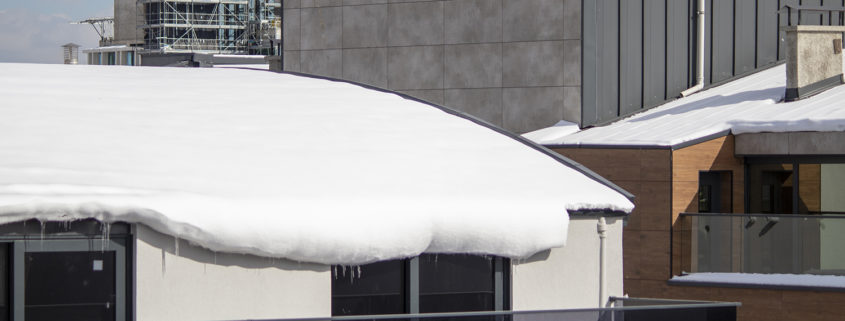Winter weather can be full of surprises from one day to the next. Freezing rain, high winds, snowstorms, and the occasional sunny day just for good measure. If your commercial building or facility is located in an area of the country that routinely sees heavy snowfall in the winter, you may have already encountered the hassles that come with the buildup of snow on your roofing system.
Whether your building has a flat roof or low slope roof, a large snow load sitting on your commercial building’s roof can turn into a major problem. We’re going to talk about what a large amount of snow accumulation means for your roof structure and the steps you can take to mitigate snow’s effects.
Snow Load Engineering
Engineers take into account the structural load of a roof when designing and constructing a building. Structural load is divided into two aspects: dead load, which is the structure’s own weight, and temporary load, which (in this case) is the weight of snow on the roof surface. According to FEMA’s Snow Load Safety Guide, there are many factors that go into determining snow load. The building’s size, amount of wind exposure, roof obstructions, and the building’s geography all play a part.
Snow accumulates evenly on roofs that are flat, anf flat roofs form the majority of commercial roofing systems. The more protrusions that a roof has, the higher the likelihood of snow drifts forming. HVAC units, skylights, vents, and solar panels can all create areas where snow drifts are able to develop. If your building has parapets, these too can create areas where snow will collect. It only takes a few inches of snow to form snow drifts when combined with high winds and snow drifts result in an uneven snow load, even on sloped roofs.
Why Snow Harms Your Roof
The first way snow harms your roof has to do with its weight. The weight of snow can vary depending on its density and how much moisture that it contains. “Dry” snow is snow that falls when the temperature is very cold. It is very light and powdery. “Wet” snow is snow that falls when the temperature is not as cold or has been rained on. “Wet” snow is heavier, but on average, the weight of a cubic foot of snow is almost 20 pounds.
When snow melts, it can cause even more issues. The worst roof damage often occurs because of the freeze/thaw cycle (which is the same cycle that creates potholes). If snow melts and the water is unable to drain properly, it will settle into any narrow gap or crevice. It then refreezes into ice and expands, tearing open your roof material and creating the risk of roof leaks.
Speaking of drainage, sometimes when snow melts on your roof, it can refreeze in the scuppers. This causes an ice dam and prevents any more water from draining off of the roof. The melting snow can also freeze down the side of your building, damaging the walls and creating the risk of dangerously large icicles. These icicles can even take some of your roof membrane with them if they fall. Luckily, this isn’t a risk with metal roofing systems.
Warning Signs of a Possible Collapse
There are warning signs to watch out for that will alert you to a possible roof collapse, and most of them are observable from within your building. Internal warning signs that you should be on the lookout for include the following:
- Falling or sagging ceiling tiles from a drop ceiling
- Sagging sprinkler heads
- Cracks in walls
- Roof leaks
- Trusses or braces that are bending or bowing
Any one of these should be a cause for concern and prompt you to schedule a roof inspection as soon as possible. Two or more of these factors combined could mean a serious emergency.
Snow Preparation is Key
Knowledge is everything when it concerns snow accumulation on the roof of your commercial property. Building owners and facility managers should be aware of the snow load of their building (or buildings) that fall under their care.
Keep in mind that building codes were not amended to address snow loads until the 1970s and 1980s. If your building or buildings are over 50 years old, and more equipment has been added to the roof since then, your building may be at risk for a roof collapse if your area receives unusually heavy snowfall.
It’s useful to have a map of your building’s roof to know where all the equipment, penetrations, and drains are so you and the roofing company you work with are aware of any spots that are at greater risk of snow drifts.
Lastly, regular roof maintenance is valuable for keeping your roof system operating as it should. Commercial flat roofs are equipped with drainage systems that move water off of the roof and to the ground below. You should have your roof inspected at least twice a year to make sure your drains are free of leaves and other material. Gutters and downspouts should also be on the inspection checklist.
The optimal times to have roof inspections done are in the spring and the fall so your roof can be prepared for any severe weather.
TEMA Roofing: Ready For Any Season
The best thing you can do for your roof is to have a trusted commercial roofing company on your side. TEMA Roofing Services specializes in all types of commercial roofing and can take on any roofing issue that you may be suffering from. TEMA even has a Roof Asset Management Program so that you’re always informed about the condition of your roof and what maintenance needs to be performed next.
Don’t be caught off guard the next time there’s heavy snow on your commercial roof. Be prepared, and contact TEMA Roofing Services today!





